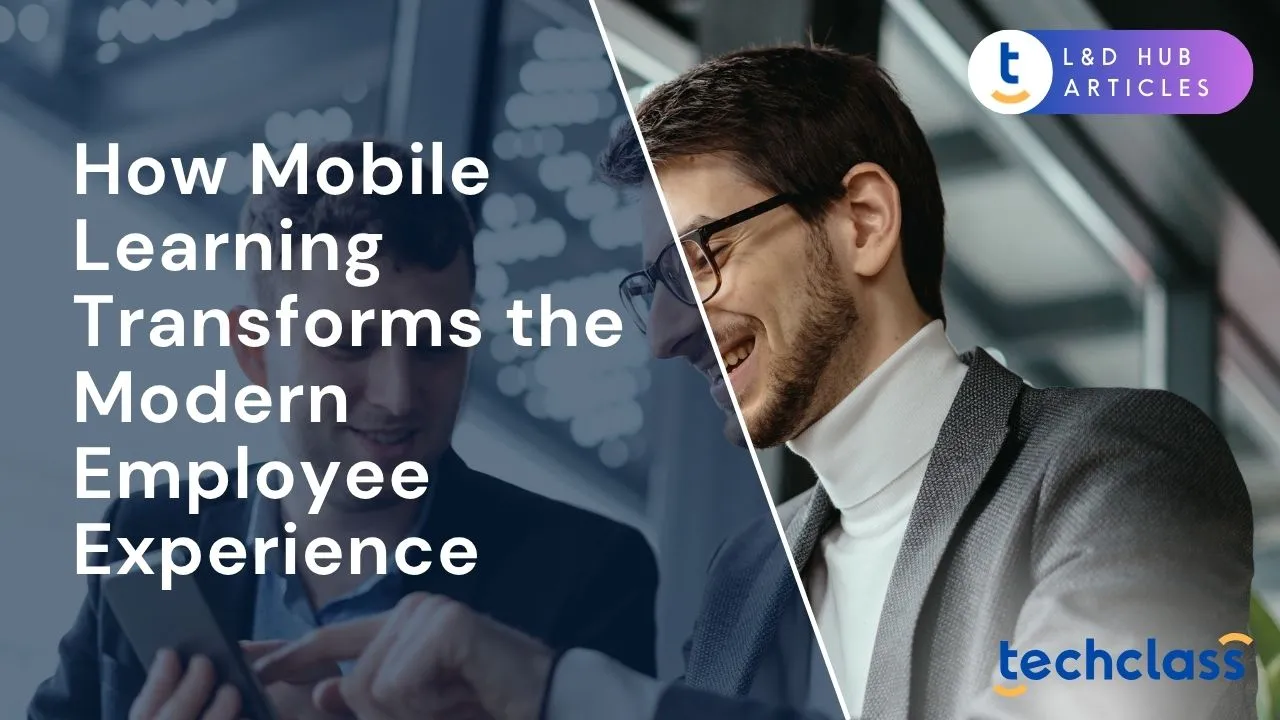
The way employees learn and develop in the workplace is undergoing a major transformation. In an era when almost everyone carries a smartphone, organizations are rethinking traditional training methods. Modern employees are on the move – whether working from home, traveling for business, or stationed on a shop floor – and they expect learning to be as agile as their work environment. Mobile learning (or “m-learning”) has emerged as a response to these changing needs, enabling training to happen anytime and anywhere. By delivering training through mobile devices, companies can provide a learning experience that aligns with how today’s workforce lives and works. This shift isn’t just about convenience; it’s redefining the employee experience by making learning more accessible, engaging, and personalized. Employees who can access knowledge on-demand through their phones or tablets feel more supported in their roles and more empowered in their growth. In short, mobile learning is quickly becoming a cornerstone of the modern employee experience, bridging the gap between continuous learning and the dynamic needs of today’s work life.
Mobile learning has gained momentum as a key trend in workplace training. Several factors have fueled this rise. First, the ubiquity of smartphones and tablets means most employees already have the tools in hand – there are billions of smartphone users globally, and many workers routinely use their mobile devices for work tasks. Traditional e-learning (accessed via desktop computers) now shares space with m-learning as organizations adapt to how people prefer to consume information. Additionally, workforce dynamics have changed. A large portion of the world’s workforce doesn’t work at a fixed desk (estimates often put this “deskless” workforce at around 80%), making desktop-based training impractical in many cases. At the same time, remote and hybrid work have become commonplace, with a significant percentage of employees working away from the office at least part of the time. These employees need flexible training options that don’t require being in a specific location. Mobile learning meets this need by allowing learning on the go, whether an employee is on a factory floor, in a client meeting, or commuting to work. Furthermore, younger generations entering the workforce (and even tech-savvy veterans) are accustomed to using mobile apps in daily life – they expect slick, user-friendly mobile experiences in their jobs as well. All these factors have converged to make mobile learning not just a nice addition but a necessary component of modern training strategies. Organizations embracing m-learning are seeing faster rollout of training and higher participation, as learning is delivered in formats that align with contemporary work-life and technology habits.
One of the most immediate ways mobile learning transforms the employee experience is by making training available anytime and anywhere. Modern employees juggle busy schedules and varied shifts, and they may not have the luxury of sitting down for a scheduled 3-hour training session. Mobile learning solves this by putting knowledge in the palm of their hand. Whether an employee is between meetings, on a lunch break, or traveling, they can access short training modules on their phone at the moment it suits them. This on-demand availability means learning no longer disrupts the workday – it fits into it. For example, a sales associate on a shop floor can quickly pull up product information or a brief how-to video on a tablet right when a customer asks a question, rather than having to recall information from a workshop weeks ago. A remote employee can complete a required compliance micro-course on their phone in the evening, instead of having to block out work hours to do it on a desktop. The result is a flexible learning experience that respects employees’ time and rhythms. Surveys back this up: a majority of learners say that accessing training on a mobile device is simply more convenient for them than traditional methods. When training is convenient, employees are more likely to engage with it rather than seeing it as a burden. “Anywhere, anytime” learning also extends to offline access – many mobile learning apps allow downloading content so that employees can even learn in environments with no internet (for instance, during a subway commute or on a flight). By fitting learning seamlessly into the flow of daily life, mobile learning reduces the friction that employees often associate with corporate training. The outcome is a workforce that can continuously learn without missing a beat in their work, leading to improved confidence and competence on the job.
Mobile learning isn’t just about portability – it’s also driving a shift in how content is delivered, with big implications for employee engagement. On small screens, long lectures or text-heavy manuals don’t work well. Instead, bite-sized learning has become the norm. Complex topics are broken into short, focused modules (often called microlearning), which might take only a few minutes each to complete. These bite-sized lessons are often video clips, interactive quizzes, or quick reading segments that employees can digest easily on a phone. This format aligns perfectly with modern attention spans and busy schedules – and it turns out to be more engaging. Employees tend to find a 5-minute interactive module far more appealing than a 50-minute slideshow. As a result, they engage more frequently and attentively with the content. Research has shown that mobile learning can dramatically boost engagement rates (one analysis found engagement increases of over 70% when training is delivered via mobile micro-content versus traditional methods). Higher engagement is only part of the story; knowledge retention also improves. By learning in small increments and immediately applying that knowledge, employees are more likely to remember what they learned. Studies indicate that microlearning can lead to significantly better retention of information – in some cases, learners retained much more (even up to 80% more) compared to conventional course formats. Furthermore, mobile learning platforms often leverage multimedia and interactive elements that capture attention: short videos, game-like quizzes, infographics, and simulations make learning more lively and enjoyable. Many apps also incorporate gamification features such as points, badges, or leaderboards, which add a fun, competitive element that keeps employees coming back. For example, completing a daily quiz on one’s phone might earn points toward a company-wide leaderboard, motivating employees to engage regularly. All these factors transform training from a passive, and sometimes tedious, experience into an active, engaging part of the workday. Employees feel more interested and involved in learning, which not only helps them build skills but also makes the overall experience with their organization more positive. An engaged learner is often a more engaged employee.
Mobile learning also empowers employees by giving them more control over when and how they learn. Unlike traditional training that occurs at a fixed time (e.g. a workshop or webinar everyone must attend together), mobile training is typically self-paced. Employees can start a course, pause, revisit sections, or advance at a speed that suits their personal learning style. This autonomy in learning has a profound effect on the employee experience. When people can learn at their own pace, they tend to feel less pressure and more ownership of the process. In fact, surveys have found that an overwhelming majority of employees prefer the freedom of self-paced learning over being forced into a one-size-fits-all session – it allows them to absorb information in a way that works best for them. This sense of ownership leads to a more positive outlook on training. Rather than viewing training as a mandatory chore handed down by management, employees see it as an opportunity they can control and fit into their development path. The benefits of this positive attitude are tangible. For example, when employees can choose how to navigate their learning, they are more likely to complete courses on time (instead of procrastinating or abandoning them) and to actively seek out additional learning opportunities. They engage with content because they want to, not just because they have to. Knowledge retention also improves because learners aren’t rushing through material at an imposed pace – they can take the time they need to truly understand it.
To illustrate, consider an employee who finds a particular concept challenging. In a live class, they might feel embarrassed to slow down the group with questions, but on a mobile platform, they can replay a tutorial video or revisit a module until they feel confident. Meanwhile, a more advanced learner can skip past basics or accelerate through material they already know. In both cases, each employee is getting a personalized learning experience that adjusts to their needs. Many mobile learning systems even use adaptive technology or AI to assist in this personalization, for instance, suggesting topics based on an employee’s role or past training history, or using quizzes to determine what content the learner should focus on next. This individualized approach makes employees feel valued and catered to, as the training acknowledges their unique background and goals. Ultimately, empowering employees with self-paced, personalized learning boosts their confidence and competence. They feel in charge of their professional growth, which contributes greatly to a positive employee experience. When employees sense that the company trusts them to manage their learning – and provides the tools to do so, it fosters a culture of continuous learning and self-improvement that benefits both the individual and the organization.
In the past, company training programs sometimes struggled to reach everyone equally. Headquarter-based staff or desk-bound employees might get more access to workshops and seminars, while frontline, field, or remote employees were left on the sidelines. Mobile learning has changed that by enabling inclusive access to training for all employees, no matter their role or location. This is a transformative shift for the overall employee experience because it levels the playing field in terms of development opportunities. For example, consider workers on a factory floor, retail associates in various store locations, delivery drivers on the road, or nurses in a hospital – these are roles where employees aren’t sitting at a computer all day. Historically, such employees might have received minimal training beyond initial orientation, simply because it was logistically difficult to pull them into a classroom or have them complete e-learning at a desk. Now, with training delivered through smartphones or tablets, a “deskless” workforce can learn without leaving their work environment. Short instructional videos, checklists, or how-to guides can be accessed on a handheld device during natural breaks in their day. A field service technician, for instance, can review a repair procedure on a tablet while at a job site. A nurse can quickly look up a protocol on her phone during a shift change.
Mobile learning ensures that learning isn’t confined to the corporate office or the training room – it reaches everyone. This inclusivity boosts morale: employees feel the company is investing in them equally, regardless of their job title or location. It can be demotivating for employees to feel “forgotten” by training programs; mobile learning prevents that by bringing knowledge to wherever the employees are. Moreover, delivering standardized training through mobile devices helps in maintaining consistency across a distributed workforce. Every employee gets the same core messages, guidance, and resources, which improves overall performance and alignment with company standards. For managers and HR, this means fewer skill gaps between centrally located teams and those in the field. From the employee’s perspective, it’s reassuring to know they won’t miss out on learning opportunities just because they aren’t in the main office. In a broader sense, mobile learning helps create a culture of unity and continuous improvement across the entire organization. Whether an employee works in an office cubicle or out in the field, they can feel connected to the company’s learning ecosystem. This inclusive approach strengthens the employee experience by showing that everyone’s growth is a priority.
Ultimately, the goal of learning and development is to improve employee performance and support career growth, and mobile learning has demonstrated clear impacts on these fronts. By providing timely, convenient training and resources, mobile learning helps employees perform better in their roles. When someone can access a tutorial or answer exactly at the moment of need, they can immediately apply that knowledge to their task, leading to better outcomes. Take an example where an employee is faced with an unfamiliar problem: instead of giving up or making a guess, they can quickly consult a how-to module or even ask a question in a mobile discussion forum. This kind of just-in-time learning support reduces mistakes and boosts confidence. Over time, as employees regularly engage in learning, they build a stronger skill set, which naturally translates to higher productivity and quality of work. There’s evidence that training delivered via mobile can be very efficient as well – one study found that employees completed certain compliance courses nearly 45% faster on smartphones than on computers, with no loss in comprehension. Faster learning cycles mean employees spend less time off the job training and more time applying skills, which benefits overall performance. Just as importantly, those employees reported a high satisfaction with the mobile format (in fact, almost all participants in that study felt the mobile learning experience supported their needs). This points to a direct improvement in the employee’s satisfaction with the training process. When training is seen as helpful and user-friendly, employees are more likely to value it rather than dread it.
All these improvements in convenience, engagement, and performance feed into larger outcomes like employee satisfaction and retention. Employees generally want to grow in their careers and appreciate when their employer facilitates that growth. Mobile learning sends a message that the company is invested in their development in a modern, accessible way. This can boost morale and loyalty. Workers who feel supported in learning new skills are more likely to feel happy in their jobs and stay with the company longer. In fact, research on employee retention consistently shows that lack of growth opportunities is a top reason people leave an organization. By contrast, companies that offer robust learning resources (especially in flexible formats like mobile) tend to have employees who are more engaged and less inclined to seek other jobs. Offering mobile learning can even enhance employer branding in the eyes of current and prospective employees. Today’s talent, especially younger professionals – often evaluate whether a company is forward-thinking and committed to employee development. Providing a slick mobile learning app with on-demand courses and development paths is a strong signal that the organization values continuous learning and keeps up with modern technology. Many job seekers consider the availability of advanced digital tools at work (including learning platforms) as part of their decision to join or stay at a company. In some cases, employees have cited outdated or insufficient technology as a reason for leaving. On the flip side, being known as a company that empowers its people with cutting-edge learning experiences can attract high-quality candidates and make existing employees proud to be a part of such an organization.
In summary, mobile learning creates a win-win: employees perform better and develop their careers, while also feeling more satisfied and supported – and employers benefit from a more skilled, engaged, and loyal workforce. The transformation in employee experience is evident in day-to-day enthusiasm and long-term retention metrics alike.
Mobile learning has moved from a novel idea to a fundamental element of the modern workplace. As we’ve explored, it does far more than put training on a smaller screen, it reshapes how employees experience growth and development in their jobs. By meeting learners where they are (both literally and figuratively), mobile learning makes continuous development a natural part of work life. It caters to the realities of today’s workforce: dispersed teams, busy schedules, and the expectation for consumer-grade technology experiences. The organizations that have embraced mobile learning are finding that their employees are not only learning faster, but are also more engaged and positive about the process. In an age where employee experience is recognized as a key driver of business success, offering convenient and effective learning opportunities is critical. Mobile learning is transformational because it aligns training with the flexibility, personalization, and connectivity that define the modern employee experience.
Looking ahead, mobile learning is likely to become even more ingrained in how companies develop their talent. As new technologies (like AI and augmented reality) further enhance mobile training, and as the workforce continues to evolve, the ability to learn on the go will be seen as an expectation rather than an exception. Enterprise leaders and HR professionals across industries should view mobile learning not just as a training tactic, but as a strategic investment in their people. When employees feel supported to learn and grow in ways that fit their lives, they are more likely to thrive, and when employees thrive, so do their organizations. In conclusion, mobile learning has proven to be a powerful tool in transforming the employee experience for the better, and it stands as a pillar for building a more agile, knowledgeable, and engaged workforce in the modern era.
Mobile learning makes training accessible, engaging, and personalized, fitting into employees' busy, mobile lifestyles for better development.
Microlearning delivers short, focused content that improves engagement, retention, and allows employees to learn quickly and effectively.
Self-paced learning gives employees autonomy, reducing pressure and increasing motivation, leading to better course completion and skill mastery.
It provides accessible, standardized training that reaches employees regardless of their role or location, fostering equity and cohesion.
It enables just-in-time support, speeds up learning, increases job confidence, and encourages career growth, boosting satisfaction and loyalty.


